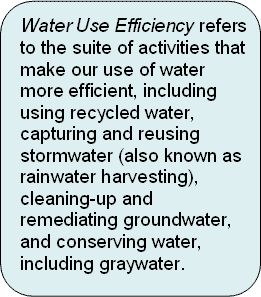At the peak of California’s most recent drought in 2009, the Los Angeles economy was in severe recession, with unemployment above 12 percent. These twin crises identified a policy opportunity to tackle both challenges together. Public investments in water use efficiency provide economic and job benefits alongside the environmental benefits from using less water. This report quantifies the economic and job benefits that result from investments in water use efficiency in Los Angeles.
Los Angeles is a major net importer of water and relies on sources several hundred miles away in Northern California and  Colorado for two-thirds of its supply. The ecosystems of these source regions are significantly impacted by decades of diverting water for agricultural, industrial and municipal use. Combined with the periodic droughts afflicting the Southwest U.S., these circumstances put Los Angeles under increasing pressure to reduce reliance on imported water by using what we have more efficiently.
Colorado for two-thirds of its supply. The ecosystems of these source regions are significantly impacted by decades of diverting water for agricultural, industrial and municipal use. Combined with the periodic droughts afflicting the Southwest U.S., these circumstances put Los Angeles under increasing pressure to reduce reliance on imported water by using what we have more efficiently.
Significant investments by public agencies that build on previous efforts are required to achieve needed gains in water use efficiency. These investments take the form of stormwater capture and treatment infrastructure, groundwater treatment equipment and recharge systems, graywater systems for homes, sub-metering multi-family housing, water de-salting facilities, indoor appliance/fixture retrofit campaigns, ecosystem restoration, and irrigation system evaluation and repair.
As dollars are spent on specialized civil engineering and construction services, the multiplier effects ripple through the local economy benefiting a wide range of employers that provide supplies and support for water use efficiency. Water use efficiency investments and their subsequent multiplier effects are quantifiable, enabling us to estimate the amount of business sales stimulated, numbers of jobs supported, top occupations hired, and average wages paid. Using this information, we identify clusters of jobs that offer career ladders to hopeful workers, industry trends of growth and decline, and opportunities for local business expansion.
We present this information in two ways. First we analyze Los Angeles’ water sector – the establishments that provide goods and services that directly build and maintain municipal water infrastructure, manufacture specialized water systems equipment, provide engineering consulting services, and provide support services for these direct providers. Second, we analyze over 50 recent water use efficiency projects in the Los Angeles region, detailing their supplier networks and multiplier effects.
Multiplier Effects for Water Use Efficiency Investments
The following table of multiplier effects is presented for comparison purposes, drawn from the report’s Executive Summary:
Table C
Job Impacts of Water Use Efficiency Projects, with Comparison to Energy Efficiency Retrofits and Traditional Industries in Los Angeles, per Million Dollars Invested
| Project Type | Total Jobs Stimulated | Average Wages |
|---|---|---|
| Water Conservation | 16.6 | $37,558 |
| Graywater Systems | 14.9 | $33,286 |
| Stormwater | 13.1 | $52,828 |
| Groundwater | 12.8 | $50,001 |
| Recycled Water | 12.6 | $49,092 |
| Energy Efficiency Retrofits^ | 13.6 | - |
| Cut and sew apparel contractors* | 24.5 | $29,534 |
| Grocery Stores* | 18.5 | $31,382 |
| Utility Systems Construction* | 13.7 | $75,305 |
| Commercial Construction* | 13.6 | $29,551 |
| Housing Construction* | 11.3 | $81,606 |
| Motion Picture & Video Production* | 8.3 | $141,254 |
Notes: ^ Data for the “Energy Efficiency Retrofits of Commercial Buildings” project type comes from the Political Economy Research Institute, UMass Amherst. 2011. “A NEW RETROFIT INDUSTRY: An analysis of the job creation potential of tax incentives for energy efficiency in commercial buildings and other components of the Better Buildings Initiative.” * Data for traditional Los Angeles industries is for reference.
Press Coverage
- Public Investments in Water Conservation Stimulates Economic Activity, by NewsBlaze service, Folsom, CA.
- Saving Water Good for Environment and Pocketbooks, by Nick Roman, KPCC radio Pasadena, CA
- How Reducing Dependence on Delta Water Creates Jobs in Southern California, by Barry Nelson, NRDC blog “SWiTCHBOARD,” San Francisco, CA
- Water Efficiency Investments Flow into Job Creation, Interview with co-author Patrick Burns, by Racquel Palmese, Green Technology Magazine, Pasadena, CA
- New Report Says Investing in Water Efficiency Boosts Jobs, Association of California Water Agencies – Water News, Local Economies, by Lisa Lien-Mager.
- Listen Up LA! We Need Good Jobs and Local Water Projects, Not a Delta Tunnel, by Pastor Clarence Moore, April 9, 2018
Press Release
Los Angeles, Calif. (December 6, 2011) –
Public investments in water conservation and water efficiency stimulate economic activity that is twice as great as the initial investment. One person-year of employment is created for each $72,400 that is invested.
The Economic Roundtable studied over $1.2 billion of investments in recent water-use-efficiency projects in the Los Angeles area – including a sample of 53 recent local stormwater, water conservation, graywater, recycled water, groundwater management and remediation projects – to find how they affect the local economy. The results were released today in a new report, Water Use Efficiency and Jobs.
The ratio of jobs stimulated for every $1million invested is comparable to energy efficiency retrofitting, and higher than many traditional Los Angeles industries such as motion picture production and new home construction.
Paula Daniels, Mayor Villaraigosa’s senior advisor on food and water policy, said “This study shows that investment in local water use efficiency projects is as important for the local economy as it is for water quality.”
Los Angeles is the most populous region of California, with average daily water use of 135 gallons per person – 49,275 gallons per person annually. Population growth and demands from other regions for an increasing share of the water that has traditionally come to Los Angeles is making it increasingly difficult and expensive for Los Angeles to import enough water to meet local demand.
Periodic droughts and the high costs of importing water from the Sacramento Delta and Colorado River Basin make the need to achieve greater water use efficiency even more urgent.
“More investment in LA County can help local businesses grow and build competitive strength in water conservation, ground water treatment or recharge, and water recycling services and technologies,” according to Gil Crozes, vice president of Carollo Engineers.
Mark Gold, president of Heal the Bay, said, “This study demonstrates that investment in green water jobs provides major economic benefits. This finding should remove all barriers to increased investments in conservation, recycling and rainwater capture – all of which would greatly augment local, reliable water supplies while improving water quality.”
The study investigated the jobs that investments in water use efficiency open up for local workers. For every $1 million dollars invested, 12.6 to 16.6 annualized jobs are created, depending on the type of project. These local jobs impacts are comparable to those stimulated through energy efficiency retrofits of commercial buildings (13.6 per $1 million), and higher than construction of new housing (11.3 per $1 million) and motion picture production (8.3 per $1 million).
According to Patrick Burns, senior researcher at the Economic Roundtable, “locating new water sources is difficult. Los Angeles needs to use the water it has more efficiently, and a dividend from doing this is that we will open doors for job seekers, including young adults eager to gain skills in the emerging field of water use efficiency.”
Findings from the Economic Roundtable’s study indicate that there are much greater local benefits from investing in local water use efficiency projects than from equivalent investments in massive statewide projects. Local investments not only produce large multiplier effects in the local economy where water users live and work, but also by encouraging conservation of this increasingly scarce resource.
“The strong local multiplier effects of water use efficiency investments are further reason for increasing local investments in water recycling and other water efficiency projects, as well as for supporting state bond measures that can leverage our local funding,” stated Sharon Green, Legislative & Regulatory Liaison at the Sanitation Districts of Los Angeles County.
Gregory Irish, executive director of Los Angeles’ Workforce Investment Board (WIB), sees a role for local government to facilitate employment opportunities. “The City can work with the community college district to establish targeted workforce training and uniform certification programs for emerging occupations in water use efficiency.”
###
Table of Contents
Executive Summary
- LA‘s Water Supply and Users
- Identifying Industries that Make up the LA Water Sector
- Industry Analysis
- Jobs and Occupations in the Water Sector
- Case Studies of Water Use Efficiency Projects in LA
- Stormwater
- Recycled Water
- Water Conservation
- Groundwater / Remediation
- Graywater Systems Installation
- Location of Investments
- Policy Recommendations
The report also includes extensive data appendices, including definitions of industries in the water sector, definitions of O*NET skills for occupations, a contributors list for water efficiency projects used in the report, and additional information about graywater systems for residential dwelling units.
Related Articles
- “Drought: 4 things Southern California is doing to capture stormwater, and 1 we’re not” KPCC 89.3 News, December 17, 2014.
- Sahagun, Louis. Army Corps to recommend $1-billion L.A. River revitalization project. May 28, 2014.













